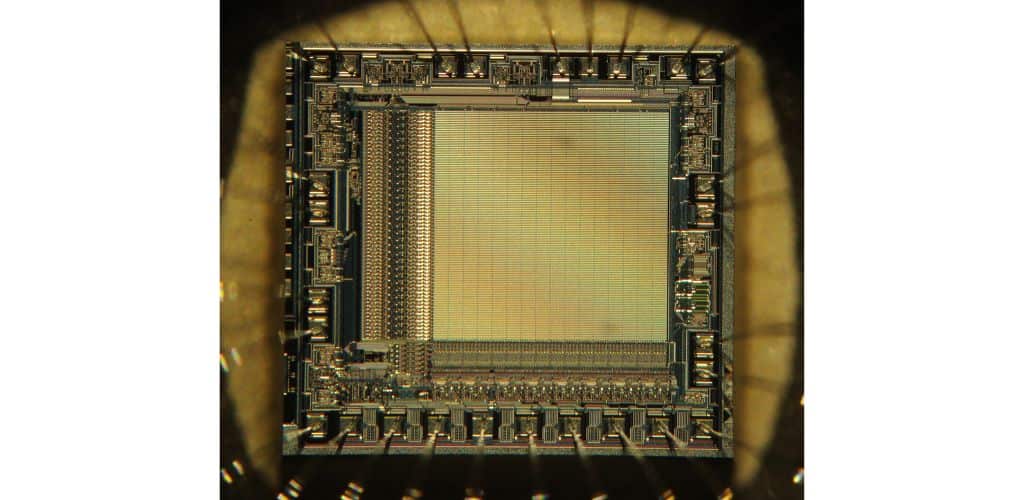The Federal Circuit has affirmed a decision of the Patent Trial and Appeal Board (PTAB or Board) finding unpatentable certain claims of a patent for making semiconductor devices.
The case is Bell Semiconductor LLC v. Advanced Semiconductor Eng’g, Inc.
Bell now owns U.S. Patent No. 6,624,007, which describes and claims methods for making semiconductor devices.
Specifically,
The ‘007 patent describes and claims methods of producing an “intermediate product” that includes a semiconductor chip mounted on a leadframe and enclosed in a “packaging layer,” then cutting that intermediate product from the surrounding leadframe in two steps to release a finished semiconductor device.
Advanced Semiconductor petitioned the United States Patent and Trademark Office (USPTO) for an inter partes review (IPR) of all of the patent’s claims under 35 U.S.C. §§ 311-319.
The Board ultimately issued a final written decision under 35 U.S.C. § 318 determining that the claims are unpatentable.
Bell appealed. It challenged the PTAB’s claim construction for three claim terms: “an intermediate product,” “packaging layer,” and “cutting the intermediate product.”
The first issue before the court was Bell’s standing as an assignee of the patent. The court
noted that
Although Bell was not the original applicant for the ‘007 patent-Rohm was-the Board properly found Bell to be the patent owner of record by the time relevant for participation as the patent owner. Patent ownership may transfer via assignment, see 35 U.S.C. § 261, but “[i]n order to request or take action in a patent matter, an assignee who is not the original applicant must establish its ownership of the patent property . . . to the satisfaction of the Director.”
With respect to the patent claims, as the court explained,
The Board construed those claim limitations, based on the “unambiguous” claim language and “consistent with the . . . [s]pecification,” as including within their scope an intermediate product with only a single chip encased in a resin packaging layer.
Bell asserted that its patent claims
all flow from the premise that “an intermediate product” must be construed to have the structure shown in Figure 16-specifically, each such intermediate product must itself include a plurality of chips, all enclosed in a continuous resin “packaging layer” that runs on and between the chips.
The Federal Circuit rejected Bell’s multi-chip view of “an intermediate product,” stating
Claim 1 claims an intermediate product that includes, by definition, “the chip” enclosed in “a packaging layer,” where “the chip” refers back to “a semiconductor chip” for its antecedent basis. (Emphasis added.) Articles like “a” and “an”- and “the” when used to refer back to “a” or “an”-must be construed to mean “one or more” unless the claim language, specification, or prosecution history demand otherwise.
Somewhat confusingly, the court noted that
Sometimes we have found context to make clear that “a” before a noun is restricted to one only (of the things named by the noun), rather than covering both one and more than one (of the noun-named things).
However said the court,
Bell has not cited examples of what in any event must be far more extraordinary-use of “a” or “an,” in patent usage or English usage outside patents, to require a plurality, excluding the singular. And nothing in claim 1’s language otherwise requires “an intermediate product” with a “packaging layer” to contain multiple chips.
The court found that the patent’s specification didn’t contradict the singular-permitting construction supported by the claim language:
Bell relies heavily on the embodiment shown in Figure 16, but “the claims of the patent will not be read restrictively” as limited to a single embodiment, even when the patent “describes only a single embodiment,” “unless the patentee has demonstrated a clear intention to limit the claim scope using ‘words or expressions of manifest exclusion or restriction.'”
Thus, the court affirmed the Board’s claim construction and its finding that the claims were unpatentable.
Just like the haiku above, we like to keep our posts short and sweet. Hopefully, you found this bite-sized information helpful. If you would like more information, please do not hesitate to contact us here.


